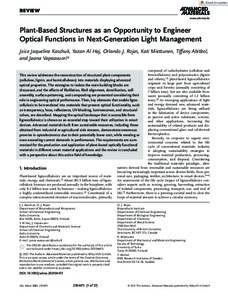Plant-Based Structures as an Opportunity to Engineer Optical Functions in Next-Generation Light Management
Abitbol Tiffany; Rojas Orlando J.; Kaschuk Joice Jaquelin; Miettunen Kati; Vapaavuori Jaana; Al Haj Yazan
Plant-Based Structures as an Opportunity to Engineer Optical Functions in Next-Generation Light Management
Abitbol Tiffany
Rojas Orlando J.
Kaschuk Joice Jaquelin
Miettunen Kati
Vapaavuori Jaana
Al Haj Yazan
Wiley-VCH
Julkaisun pysyvä osoite on:
https://urn.fi/URN:NBN:fi-fe2022020818030
https://urn.fi/URN:NBN:fi-fe2022020818030
Tiivistelmä
This review addresses the reconstruction of structural plant components (cellulose, lignin, and hemicelluloses) into materials displaying advanced optical properties. The strategies to isolate the main building blocks are discussed, and the effects of fibrillation, fibril alignment, densification, self-assembly, surface-patterning, and compositing are presented considering their role in engineering optical performance. Then, key elements that enable lignocellulosic to be translated into materials that present optical functionality, such as transparency, haze, reflectance, UV-blocking, luminescence, and structural colors, are described. Mapping the optical landscape that is accessible from lignocellulosics is shown as an essential step toward their utilization in smart devices. Advanced materials built from sustainable resources, including those obtained from industrial or agricultural side streams, demonstrate enormous promise in optoelectronics due to their potentially lower cost, while meeting or even exceeding current demands in performance. The requirements are summarized for the production and application of plant-based optically functional materials in different smart material applications and the review is concluded with a perspective about this active field of knowledge.
Kokoelmat
- Rinnakkaistallenteet [19207]
